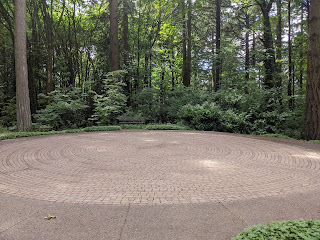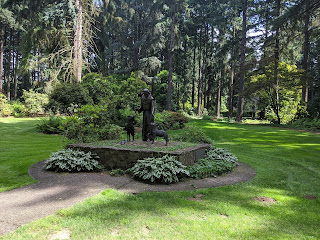After visiting Portland's fabulous Washington Park, we drove to The Grotto, also called the National Sanctuary of Our Sorrowful Mother. The story began with a young boy, Ambrose Mayer, in Kitchener, Ontario, in my native Canada, who learned his mother was near death after giving birth to his sister.
He promised to one day "undertake a great work for the Church" while praying for his mother's life. When she survived, the future Father Ambrose never forgot his promise. After he was sent by his Servite Order superiors to Portland, he bought this land in 1923 to honor Mary. The following year, the Portland Archbishop dedicated the Sanctuary of Our Sorrowful Mother. The shrine and sanctuary have since been maintained as a place of reflection for all faiths. It was designated as a National Sanctuary in 1983.
We could have just walked around the statues and chapel on the Plaza Level for free but opted to pay the admission fee and take the elevator to the manicured gardens and grottoes above the rock face.
The Marilyn Moyer Meditation Chapel was named after The Grotto's founder's mother and was accessible after we reached the top of the sanctuary.
The chapel's sculpture of Madonna and Child was built in 1951 to celebrate "the miracle of motherhood, and the never-ending love of a mother for her child."
The Upper Gardens included about a dozen sculptured bronze, wood and marble shrines. The first one we came across was St. Jude Thaddeus.
The next place for quiet reflection was St. Joseph's Grove.
Even if one wasn't interested in The Grotto for its religious significance, it was a place of incredible solitude and natural beauty.
St. Anne's Chapel:
Lay visitors couldn't enter the Servite Monastery in the Upper Gardens. The Servite Order or Servants of Mary was begun in 1233 in Florence, Italy, when seven men who belonged to a society dedicated to the Virgin Mary experienced personal apparitions. Those called them to leave their families and jobs to form a religious community to give their lives over to prayer and service to the Catholic Church.
Pope Leo XIII canonized the order's seven founders under the heading of "The Seven Holy Founders of the Servants of Mary." The Servite Order has spread throughout the world over the centuries while expanding their mission to include poor people and immigrants.
In the center of the rose garden was the Assumption of Mary Statue.
The Peace Pole was placed here in May, 1988, to symbolize the membership of the shrine in the Society of Prayer for World Peace.
I could go on and on about The Grotto's beauty but I think these pictures speak for themselves.
These images reflecting the church's Glorious Mysteries were sculpted in 1989.
The Grotto Labyrinth was a replica of the medieval labyrinth at the Chartres Cathedral in France. The labyrinth could be used as a meditative walk, a spiritual pilgrimage, or a healing journey. I would have liked to walked the single path at my own pace and in silence but some young children had found it before we did, so it was not really a place for quiet reflection then!
The images of the church's Luminous Mysteries were sculpted in 2005.
The Lithuanian Shrine was definitely not one we'd anticipated seeing in the gardens.
The Our Lady of Czestochowa Shrine was dedicated to the Black Madonna in Poland whose statue we were lucky enough to view several years ago.
The Our Lady of La Vang Shrine referred to a reported Marian apparition at a time when Catholics were persecuted and killed in Vietnam.
The Damabana Shrine represented the Philippines as dambana was a Filipino word for "altar." I read that the shrine was a sanctuary that brought together faith and culture of the Filipino people.
Take another look at the shrine's roof that was shaped like a traditional Filipino wide-brimmed hat. The shrine's walls were made of capiz, a flat seashell commonly used on windows of Filipino homes.
The mosaics in the Shrine of Our Lady of Guadalupe told the story of Our Lady's appearance in 1531 to an Aztec Indian who had converted to the Catholic faith.
This was a close-up view of the statue of Mary Our Mother that we'd initially seen at a great distance from the plaza level.
If you're ever in Portland, I can't tell you how strongly I would recommend you to visit The Grotto, regardless of your religious faith, as it is a place of such serenity and peace as well as natural beauty.
Though Steven and I had already had a pretty full day, exploring two terrific memorials, the International Rose Test Garden and The Grotto, he suggested we still drive to northeast Portland to walk through the Alberta Arts District. As one of the city's oldest neighborhoods, it reflected Portland's Latino, Asian, and African-American roots.
I especially was really excited seeing the vibrant murals throughout the district.
Tragically, this was but an abbreviated list of Black men and women who have died at the hands of police due to excessive force.
This whimsical one was a pleasant break from the somber race-related mural.
It had been a long time since I had seen a French-language sign but it made sense when I realized it was located near a French restaurant. The words translated to "Black Lives Matter."
Next post: Our first stops on the spectacular Columbia River Gorge.
Posted on October 3rd, 2020, from our favorite state park on the Florida Panhandle. It's apropos, given the mural above, to say Keep Your Chin Up in this extraordinarily challenging time with so many crises facing us at once.






























































What a beautiful tribute to faith this Grotto is... a forever memory to Father Ambrose's mom who, to him, signified the power of prayer. Stay well dear friend !
ReplyDeleteFun getting some 'Canadian content' in faraway Portland with a fabulous stroll through the mountaintop grotto and the testament to Father Ambrose's faith.
DeleteYes, what a beautiful 'stroll' through the grotto, Annie; thank you for sharing it. Safe travels and stay healthy!
ReplyDeleteAfter hearing incessantly all about the protests that have been taking place in Portland this summer, it was truly a wonderful escape to enjoy the peace and serenity of the grotto atop the mountain.
ReplyDelete